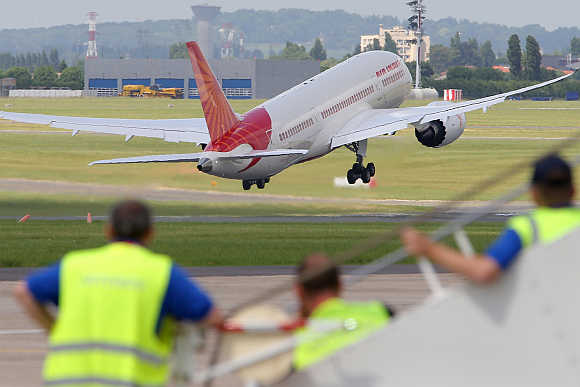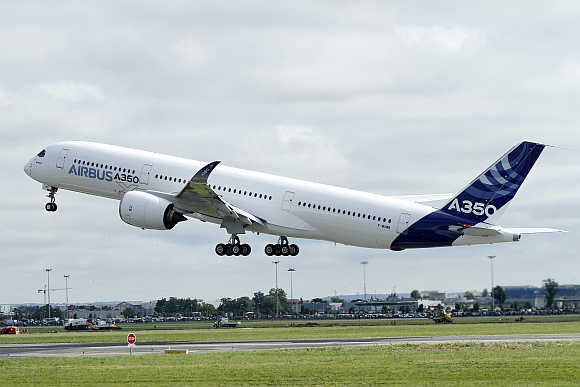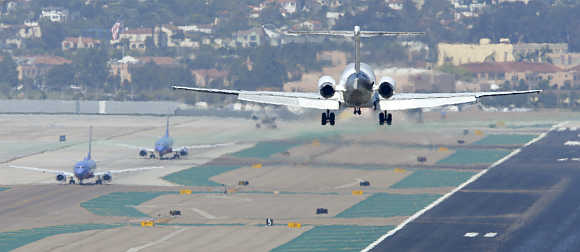Photographs: Pascal Rossignol/Reuters
As plane manufacturers gathered outside Paris to show off their newest high-tech jetliners, a less-heralded technology story was unfolding back home on the factory floors of the world's leading aerospace firms.
The planned introduction of at least half a dozen new plane designs that push the boundaries of flight performance has given the industry its biggest opportunity in a decade or more to automate factories, add new techniques and reduce costs.
In five years, planes entering service may have an engine with parts delicately fabricated by an industrial 3-D printer, a paint job applied by a robot and rivets installed by machines. "The big next leaps will come on the production side - how do we actually produce these aeroplane faster, more efficiently, with more automation?" Ray Conner, CEO of Boeing's commercial airplane division, asked at the Paris Air Show.
Unlike the car industry, aerospace has been slow to automate. Relatively low production - Boeing and Airbus produce about 1,200 jets a year - often does not justify the big investments required. Complexity and regulation also limit change, meaning much of a jet is still handmade.
But now, flush with a record number of jet orders, the industry is gearing its factories to produce at high volume and low cost. More than 35,000 jets worth $4.8 trillion will be sold in the next 20 years, according to Boeing's forecast.
...
Flush with orders, aerospace industry retools for future
Image: A British Airways Airbus A380 lands at the Le Bourget airport near Paris.Photographs: Pascal Rossignol/Reuters
Cutting costs is the only way to improve margins in a business where steep price discounts can mean selling at slim profit or a loss to win orders. Since 60 per cent to 70 per cent of a plane's materials come from suppliers, manufacturers also are pushing them to innovate, and rewarding those that do by splitting the gains.
Military suppliers, under pressure from government spending cuts, are streamlining their factories, too. Blackhawk helicopter market Sikorsky, for example, hired German automaker Porsche to advise it on production three years ago.
"It's going to really rip through the industry in the next five to 15 years," as next-generation planes enter production, said David Fitzpatrick, leader of the North American aerospace and defence practice at AlixPartners, a consulting company.
In Cincinnati, GE Aviation is designing engines for next-generation jets that will burn 15 per cent to 20 per cent less fuel than existing models. Among the innovations to achieve that savings, GE is testing 3-D printers that build up thin layers of nickel-metal alloy into fully functioning parts.
GE aims to print an advanced fuel nozzle tip that can withstand temperatures of 3,000 degrees inside the CFM International LEAP engine by the time the engine enters service in 2016 on the Airbus A320.
...
Flush with orders, aerospace industry retools for future
Image: An Air India Airlines Boeing 787 Dreamliner takes off for a flying display during the 50th Paris Air Show at the Le Bourget airport near Paris.Photographs: Pascal Rossignol/Reuters
It also will power Boeing's rival 737MAX. CFM, a joint venture of GE and Safran of France, says this will be the first production use of so-called additive manufacturing technology in commercial aviation. With nearly 3,500 of the planes sold, CFM is committed to producing about 1,700 engines a year by 2020. Pratt & Whitney also is producing engines and is not using printing technology.
Printing would eliminate the need to mill the nozzle down from a larger piece of metal, which often removes 90 per cent of the material, and to add 25 braise joints, dramatically reducing cost and cutting manufacturing time from months or more to hours or days, said Gareth Richards, LEAP program manager for CFM International.
More importantly, printing allowed GE engineers to design the nozzle without the constraints milling and braising imposed, allowing a better part that increased the fuel savings. "This manufacturing technology that we're putting in place is required because we couldn't create the designs without it," David Joyce, CEO of GE Aviation.
In a World War 2-era factory near Seattle where Boeing makes its best-selling 737, the company has used Toyota lean manufacturing principles and a moving assembly to nearly triple production to 38 jets a month since 2000. Higher production gives the plant more capacity using the same space and helps lower the cost of each plane.
...
Flush with orders, aerospace industry retools for future
Image: Airbus A350 takes off at the Toulouse-Blagnac airport in southwestern France.Photographs: Jean-Philippe Arles/Reuters
Another 10 per cent improvement is due by mid-2014, as Boeing ramps up to 42 737s per month, the equivalent of two every working day. Boeing aims to do this while reconfiguring the plant to build its next-generation 737MAX, which has 1,441 orders, after picking up 60 firm orders on Monday.
"We're going to keep working with the supply chain to see if we can go even faster," said Beverly Wyse, 737 program manager. At its massive factory north of Seattle, Boeing adopted a moving line for its 777 plane, boosting production nearly 19 percent since 2006, Boeing says.
Now it is using robotic arms to paint wings for its 777 minijumbo, adapting machines long used in the auto industry. The switch from humans allows more consistent paint thickness and is expected to result in significant savings, says Jason Clark, manager of the 777 production line. Eventually the entire plane could be painted robotically.
Airbus also still paints planes by hand. Conner declined to say how much Boeing expects to save through the measures, but acknowledged it has targets. He does not want Wall Street to monitor them, he said.
Boeing's factory overhauls include even tiny parts. Plastic zip-ties that hold bundles of wire together on the 737, for example, were replaced with tape to eliminate chafing and speed installation of the bundles, saving production time and the need for costly repairs if the wire insulation is damaged.
...
Flush with orders, aerospace industry retools for future
Image: A plane carrying soccer players of Borussia Dortmund, and painted in the clubs colours, takes-off from Dortmund's airport in Germany, on its way to London.Photographs: Wolfgang Rattay/Reuters
Airbus has honed the processes in its assembly plant in Toulouse, allowing it to clone the system at plants in Hamburg, Germany, Teijin, China, and Mobile, Alabama, where it broke ground for a $600 million plant in April. Airbus uses stationary lines, with most jets assembled four abreast in parallel bays, to avoid halting production if a problem halts a line.
The company focuses on doing as many tasks as possible at the same time, a strategy that has cut assembly time 30 per cent. Wings used to go on center fuselage sections first, for example, then other fuselage sections were added, and finally internal systems were turned on and tested.
Airbus realised that building the fuselage first allowed workers to power up the internal systems while the wings were going on, so the work could progress in parallel and cut time. "We're always trying to find more ways of doing more things in parallel, faster," said Alan Pardoe, head of marketing communications at Airbus.
...
Flush with orders, aerospace industry retools for future
Image: A passenger plane approaches to land as other aircraft taxi to the runway at the San Diego International Airport in California.Photographs: Mike Blake/Reuters
Canadian plane and train maker Bombardier is due this month to make a first flight with its new CSeries plane, the first all-new single-aisle jetliner made with advanced materials. It says it is on track to get the jet into service next year, as planned.
In planning the factory, it took advantage of automotive technology, said Guy Hachey, COO of Bombardier's aerospace division, who is a veteran of General Motors. Once again, it planned for growth. It installed tooling to build 120 planes a year but designed a factory to produce double that number.
"We have the land, the plans and the scale of the program to go twice that," Hachey said.








article